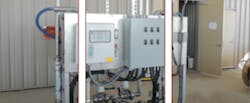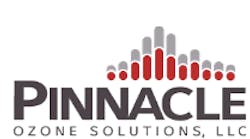In the spring of 2015, the City of Abilene, Texas, completed upgrades to the Hamby Water Reclamation Facility (WRF) to allow for a 7 mgd average and up to a 9 mgd peak flow for water reuse. Reuse-quality effluent is achieved via a biological nutrient removal (BNR) + membrane bioreactor (MBR) process, with treated flow split between parallel reverse osmosis (RO) and ozone (O3) + biologically activated carbon (BAC) treatment trains. The dual-process system provides the lowest total operating cost while achieving the highest level of treatment. Pinnacle’s modular ozone generator system was selected for the project based on its built-in redundancy; low-maintenance, user-friendly operation; and low total cost. The new system goes online in April 2015. Future work at the site will evaluate both parallel treatment trains for their performance in removing trace organics and endocrine-disrupting compounds (EDCs) in water reuse applications.
Background
The City of Abilene is located approximately 180 miles west of the Dallas-Fort Worth area in west-central Texas. Prolonged drought across central and western Texas since 2009 has resulted in significant depletion of local surface water supplies across the region. In order to provide for its long-term water security, the City of Abilene launched a major water reuse project in the summer of 2012. The project involves the expansion and retrofit of the Hamby plant in order to provide up to 9 mgd of reclaimed water to resupply the Lake Fort Phantom Hill Reservoir.
Retrofit of the Hamby plant required a combination of highly advanced treatment processes in order to avoid long-term water-quality impacts to the reservoir. Wastewater flow at the plant is split between two advanced process trains in order to achieve the highest process flexibility and lowest treatment cost.
Approach
Wastewater flow entering the Hamby plant is treated via an advanced BNR + MBR process to provide the highest quality treated effluent. Approximately 60% of biologically treated effluent is then passed to the RO process to remove total dissolved solids (TDS). Although this treatment scheme was briefly considered for the entire project, it was not selected due to the high costs of operating the RO process and the need for alkalinity replacement and stabilization of treated effluent. For these reasons, a parallel advanced O3 + BAC treatment process was selected for the site.
Approximately 40% of treated effluent flow—up to 3.6 mgd, peak—is processed via O3 + BAC treatment. The O3 + BAC process was selected based on extensive pilot and laboratory testing of samples from the site, which revealed its superior ability to remove nutrients, trace organics and other emerging compounds and EDCs from treated effluent. Although the O3 + BAC is currently only treating 2.8 mgd with expected peak flows of up to 3.6 mgd, the system was designed to accommodate up to 4.2 mgd to provide additional process flexibility.
Although an ultraviolet/advanced oxidation-based process was considered, the limited transmissivity of the treated wastewater and the cost of hydrogen peroxide made operating costs prohibitively high. Beyond the cost factors, laboratory testing also revealed the superior organics/EDC removal performance of the O3 + BAC process. While the ozone-based process also provides disinfection of treated effluent, the plant does not currently take disinfection credits for this performance, but it may do so in the future. Among the primary advantages of the O3 + BAC process is its much lower treatment cost compared to the RO process train.
Treated effluent from both the BNR + MBR + RO and BNR + MBR + O3 + BAC processes are blended prior to discharge. Up to approximately 9 mgd of treated flow is recovered to the Lake Fort Phantom Hill Reservoir, while excess treated flow is discharged to the exiting surface water outfall.
Selection of the ozone generator technology focused on flexibility, usability and reliability. Based on a review of options, Pinnacle Ozone Solutions was selected to provide ozone equipment for the project.
To ensure seamless project delivery, Pinnacle was tasked to provide all aspects of the ozone process. The scope of supply included on-site liquid oxygen storage and a delivery system; a Zenith 20X ozone generator platform; a closed-loop chilled water cooling system; a 455-gpm side-stream ozone injection system; ozone off-gas collection and destruction; and complete ozone process controls and automation.
Pinnacle’s ozone generator technology was selected based on its high performance, low projected lifetime cost and superior value for the project. The engineering team for the project appreciated the benefits of complete ozone process controls integration in the Pinnacle unit, while operations staff liked the very low maintenance and user-friendly interface of the system. The built-in redundancy of the Pinnacle system was also an important consideration for the project, as it eliminated the need for standby ozone generator equipment and helped reduce overall project cost. Finally, the Pinnacle’s superior energy efficiency and high turndown capabilities at constant ozone concentration provided the lowest operating cost and greatest flexibility for the treatment process.
Results
Construction of the Hamby WRF was completed in the spring of 2015, and the system will be online by mid-April. Looking forward, the Hamby plant and its designers hope to carefully monitor the performance of RO and O3 + BAC processes as they operate in parallel. Of particular interest is the evaluation of operating cost and EDC/trace organics removal from both processes. To this end, additional testing is being conducted and a detailed EDC monitoring plan is being developed; it will be implemented in the summer of 2015.



